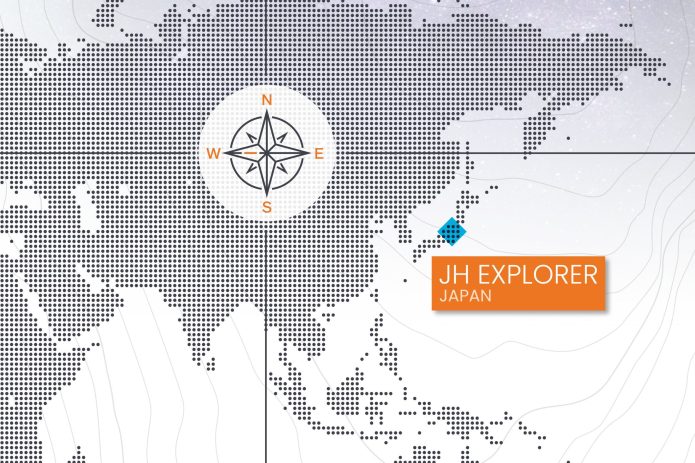JH Explorer in Japan: Sustainability and digitalization
Aaron Scully, Global Sustainable Equities portfolio manager, highlights three key takeaways from his recent trip to Japan.

5 minute read
Key takeaways:
- Japan is advanced in its sustainability practices, yet the country is behind the curve with regards to digitalisation of the economy.
- Japanese policy highlights digitalisation, climate change and innovation as being key to building economic security.
- We believe that a focus on digitalisation and near-shoring could offer opportunities for investors.
| The JH Explorer series follows our investment teams across the globe and shares their on-the-ground research at a country and company level. |
Japan is renowned for its rich history, idyllic landscape and one-of-a-kind inventions. It is also home to the oldest known business in the world, Kongō Gumi, a construction firm specializing in temples and shrines, founded in 578 AD. With this wealth of business experience in mind, I took a trip to Japan to learn more about the companies that operate there as well as its economic and political climate. These were my key findings:
1. Sustainability is becoming ubiquitous
The idea of sustainability is not new to Japan; the ancient concept of “Mottainai” – to respect and not waste resources – has sustainability embedded into Japanese culture. According to the UN’s Sustainable Development Report Japan ranks 19th out of 193 Member States in terms of its progress towards achieving the Sustainable Development Goals, putting it among the top countries in Asia with regards to sustainability. Indeed, Japan has become a leader in championing sustainability efforts in Asia with many of its policies and initiatives in line with the 2030 Agenda for Sustainable Development.
It should perhaps have been no surprise then to be greeted by a billboard promoting sustainable innovation at Tokyo’s Haneda Airport and to come across an advert for Climate Group’s EP100 initiative on a TV in the back of a taxi. In my short time there it became clear that sustainability is a key focus for Japanese policy.

2. Japanese companies are finding it increasingly more difficult to find workers
Japan has the highest proportion of elderly citizens of any country in the world, which puts a great deal of pressure on its labor force. This reality has been exacerbated by the measures imposed at the onset of the COVID pandemic, which saw a decrease in foreign workers and a smaller portion of the labor force return to work after restrictions were lifted. Difficulty finding workers was a relatively common theme in the company meetings that I attended, with many management teams expressing that this could limit their ability to grow over the medium and long term.
Digitalization can offer a solution to labor shortages in many cases by filling critical but often mundane roles. Doing so enables companies to realise efficiencies and creates space for more meaningful roles that are more appealing to workers. But while this may be a good solution, the Japanese economy is currently behind the curve when it comes to digitalization relative to the rest of the Western world.
The good news for investors is that companies which offer automation and business solution services are well placed to benefit from this theme as the need for digitalization increases. These businesses could include tools which support business operations such as TechnoPro, a technology-focused staffing and services company, or cloud computing tools such as those provided by Rakus, a cloud services provider for small and medium-sized enterprises (SMEs). Digitalization also allows for companies to utilize data-driven insights to better understand customers, identify inefficiencies and improve existing functions, which should ultimately provide benefits for all stakeholders.

3. Japanese companies are moving operations away from China
It became apparent upon meeting many Japanese companies that they are becoming more aggressive in their intentions to decouple from China. This was evident in the fact that some of the companies that I met with are choosing to build more manufacturing capacity outside of China and ensuring that critical technology is nowhere near Chinese shores. While the extent of any threat that China poses to Japan is up for debate, these actions clearly signal plans to take back control of strategically important industries and operations.
It should be noted that Japan is not alone in these efforts. Companies across Europe and North America have begun reshoring operations and supply chains as the weaknesses associated with globalization have become a reality over the past two years. Interestingly, we have seen many developed world policymakers put sustainability at the core of policies intended to rebuild a sustainable and digital economy. In a policy speech by Japanese Prime Minister Fumio Kishida, the intended post-COVID growth strategy “will work to resolve social issues, including digitalization, climate change, economic security and science, technology and innovation”.
As the sun sets over an era of globalization, we expect that the new environment – in which economic security goes hand in hand with digitalization and sustainability – will offer plenty of opportunities for investors globally.

UN Sustainable Development Goals (SDGs) are a collection of 17 global goals adopted by the UN which intend to create global positive change by 2030. Among other things, the SDGs are an agenda to end poverty, promote equality, create prosperity and protect the planet.
EP100 is a global initiative led by the international non-profit Climate Group, bringing together over 120 energy smart businesses committed to measuring and reporting on energy efficiency improvements.
References made to individual securities do not constitute a recommendation to buy, sell or hold any security, investment strategy or market sector, and should not be assumed to be profitable. Janus Henderson Investors, its affiliated advisor, or its employees, may have a position in the securities mentioned.
Environmental, Social and Governance (ESG) or sustainable investing considers factors beyond traditional financial analysis. This may limit available investments and cause performance and exposures to differ from, and potentially be more concentrated in certain areas than, the broader market.
Queste sono le opinioni dell'autore al momento della pubblicazione e possono differire da quelle di altri individui/team di Janus Henderson Investors. I riferimenti a singoli titoli non costituiscono una raccomandazione all'acquisto, alla vendita o alla detenzione di un titolo, di una strategia d'investimento o di un settore di mercato e non devono essere considerati redditizi. Janus Henderson Investors, le sue affiliate o i suoi dipendenti possono avere un’esposizione nei titoli citati.
Le performance passate non sono indicative dei rendimenti futuri. Tutti i dati dei rendimenti includono sia il reddito che le plusvalenze o le eventuali perdite ma sono al lordo dei costi delle commissioni dovuti al momento dell'emissione.
Le informazioni contenute in questo articolo non devono essere intese come una guida all'investimento.
Comunicazione di Marketing.
Important information
Please read the following important information regarding funds related to this article.
- Le Azioni/Quote possono perdere valore rapidamente e normalmente implicano rischi più elevati rispetto alle obbligazioni o agli strumenti del mercato monetario. Di conseguenza il valore del proprio investimento potrebbe diminuire.
- Le azioni di società a piccola e media capitalizzazione possono presentare una maggiore volatilità rispetto a quelle di società più ampie e talvolta può essere difficile valutare o vendere tali azioni al momento e al prezzo desiderati, il che aumenta il rischio di perdite.
- Un Fondo che presenta un’esposizione elevata a un determinato paese o regione geografica comporta un livello maggiore di rischio rispetto a un Fondo più diversificato.
- Questo Fondo può avere un portafoglio particolarmente concentrato rispetto al suo universo d’investimento o altri fondi del settore. Un evento sfavorevole riguardante anche un numero ridotto di partecipazioni potrebbe creare una notevole volatilità o perdite per il Fondo.
- Il Fondo si attiene a un approccio d’investimento sostenibile, il che potrebbe condurlo ad essere sovrappesato e/o sottopesato in alcuni settori e pertanto ad ottenere performance diverse da quelli di fondi con obiettivi analoghi, ma che non si avvalgono di criteri d’investimento sostenibile per la selezione dei titoli.
- Il Fondo potrebbe usare derivati al fine di ridurre il rischio o gestire il portafoglio in modo più efficiente. Ciò, tuttavia, comporta rischi aggiuntivi, in particolare il rischio che la controparte del derivato non adempia ai suoi obblighi contrattuali.
- Qualora il Fondo detenga attività in valute diverse da quella di base del Fondo o l'investitore detenga azioni o quote in un'altra valuta (a meno che non siano "coperte"), il valore dell'investimento potrebbe subire le oscillazioni del tasso di cambio.
- Se il Fondo, o una sua classe di azioni con copertura, intende attenuare le fluttuazioni del tasso di cambio tra una valuta e la valuta di base, la stessa strategia di copertura potrebbe generare un effetto positivo o negativo sul valore del Fondo, a causa delle differenze di tasso d’interesse a breve termine tra le due valute.
- I titoli del Fondo potrebbero diventare difficili da valutare o da vendere al prezzo e con le tempistiche desiderati, specie in condizioni di mercato estreme con il prezzo delle attività in calo, aumentando il rischio di perdite sull'investimento.
- Il Fondo potrebbe perdere denaro se una controparte con la quale il Fondo effettua scambi non fosse più intenzionata ad adempiere ai propri obblighi, o a causa di un errore o di un ritardo nei processi operativi o di una negligenza di un fornitore terzo.
Specific risks
- Le Azioni/Quote possono perdere valore rapidamente e normalmente implicano rischi più elevati rispetto alle obbligazioni o agli strumenti del mercato monetario. Di conseguenza il valore del proprio investimento potrebbe diminuire.
- Le azioni di società a piccola e media capitalizzazione possono presentare una maggiore volatilità rispetto a quelle di società più ampie e talvolta può essere difficile valutare o vendere tali azioni al momento e al prezzo desiderati, il che aumenta il rischio di perdite.
- Il Fondo si attiene a un approccio d’investimento sostenibile, il che potrebbe condurlo ad essere sovrappesato e/o sottopesato in alcuni settori e pertanto ad ottenere performance diverse da quelli di fondi con obiettivi analoghi, ma che non si avvalgono di criteri d’investimento sostenibile per la selezione dei titoli.
- Il Fondo potrebbe usare derivati al fine di ridurre il rischio o gestire il portafoglio in modo più efficiente. Ciò, tuttavia, comporta rischi aggiuntivi, in particolare il rischio che la controparte del derivato non adempia ai suoi obblighi contrattuali.
- Qualora il Fondo detenga attività in valute diverse da quella di base del Fondo o l'investitore detenga azioni o quote in un'altra valuta (a meno che non siano "coperte"), il valore dell'investimento potrebbe subire le oscillazioni del tasso di cambio.
- Se il Fondo, o una sua classe di azioni con copertura, intende attenuare le fluttuazioni del tasso di cambio tra una valuta e la valuta di base, la stessa strategia di copertura potrebbe generare un effetto positivo o negativo sul valore del Fondo, a causa delle differenze di tasso d’interesse a breve termine tra le due valute.
- I titoli del Fondo potrebbero diventare difficili da valutare o da vendere al prezzo e con le tempistiche desiderati, specie in condizioni di mercato estreme con il prezzo delle attività in calo, aumentando il rischio di perdite sull'investimento.
- Il Fondo potrebbe perdere denaro se una controparte con la quale il Fondo effettua scambi non fosse più intenzionata ad adempiere ai propri obblighi, o a causa di un errore o di un ritardo nei processi operativi o di una negligenza di un fornitore terzo.
- Il Fondo segue uno stile d’investimento di tipo “growth” che privilegia determinati tipi di società. Conseguentemente, il Fondo potrebbe sottoperformare o sovraperformare significativamente la media del mercato.




